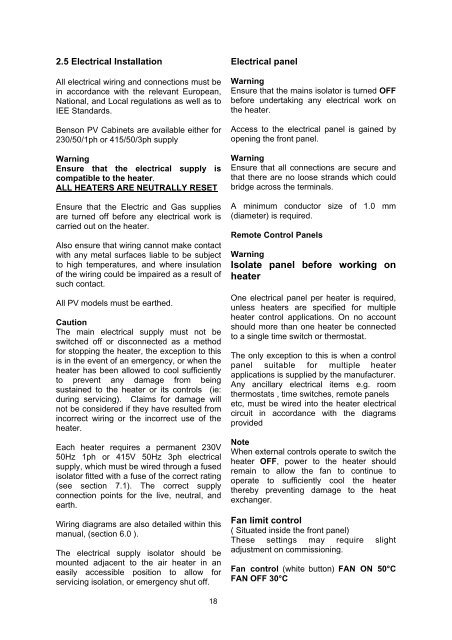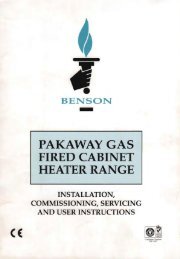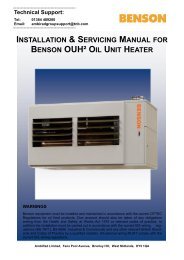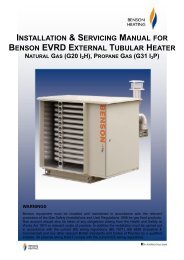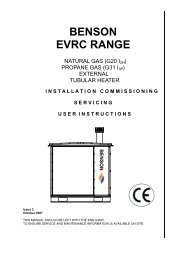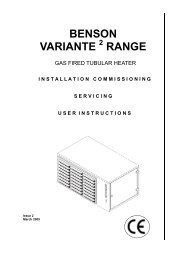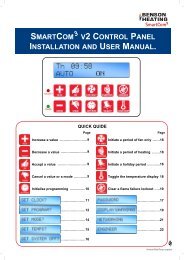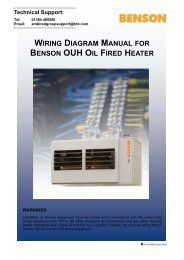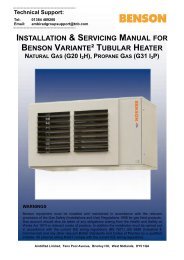INSTALLATION & SERVICING MANUAL BENSON PV TUBULAR CABINET HEATER
DONOTUSE Benson PV Range Mar2011 issue11 - AmbiRad
DONOTUSE Benson PV Range Mar2011 issue11 - AmbiRad
- No tags were found...
You also want an ePaper? Increase the reach of your titles
YUMPU automatically turns print PDFs into web optimized ePapers that Google loves.
2.5 Electrical Installation<br />
All electrical wiring and connections must be<br />
in accordance with the relevant European,<br />
National, and Local regulations as well as to<br />
IEE Standards.<br />
Benson <strong>PV</strong> Cabinets are available either for<br />
230/50/1ph or 415/50/3ph supply<br />
Warning<br />
Ensure that the electrical supply is<br />
compatible to the heater.<br />
ALL <strong>HEATER</strong>S ARE NEUTRALLY RESET<br />
Ensure that the Electric and Gas supplies<br />
are turned off before any electrical work is<br />
carried out on the heater.<br />
Also ensure that wiring cannot make contact<br />
with any metal surfaces liable to be subject<br />
to high temperatures, and where insulation<br />
of the wiring could be impaired as a result of<br />
such contact.<br />
All <strong>PV</strong> models must be earthed.<br />
Caution<br />
The main electrical supply must not be<br />
switched off or disconnected as a method<br />
for stopping the heater, the exception to this<br />
is in the event of an emergency, or when the<br />
heater has been allowed to cool sufficiently<br />
to prevent any damage from being<br />
sustained to the heater or its controls (ie:<br />
during servicing). Claims for damage will<br />
not be considered if they have resulted from<br />
incorrect wiring or the incorrect use of the<br />
heater.<br />
Each heater requires a permanent 230V<br />
50Hz 1ph or 415V 50Hz 3ph electrical<br />
supply, which must be wired through a fused<br />
isolator fitted with a fuse of the correct rating<br />
(see section 7.1). The correct supply<br />
connection points for the live, neutral, and<br />
earth.<br />
Wiring diagrams are also detailed within this<br />
manual, (section 6.0 ).<br />
The electrical supply isolator should be<br />
mounted adjacent to the air heater in an<br />
easily accessible position to allow for<br />
servicing isolation, or emergency shut off.<br />
Electrical panel<br />
Warning<br />
Ensure that the mains isolator is turned OFF<br />
before undertaking any electrical work on<br />
the heater.<br />
Access to the electrical panel is gained by<br />
opening the front panel.<br />
Warning<br />
Ensure that all connections are secure and<br />
that there are no loose strands which could<br />
bridge across the terminals.<br />
A minimum conductor size of 1.0 mm<br />
(diameter) is required.<br />
Remote Control Panels<br />
Warning<br />
Isolate panel before working on<br />
heater<br />
One electrical panel per heater is required,<br />
unless heaters are specified for multiple<br />
heater control applications. On no account<br />
should more than one heater be connected<br />
to a single time switch or thermostat.<br />
The only exception to this is when a control<br />
panel suitable for multiple heater<br />
applications is supplied by the manufacturer.<br />
Any ancillary electrical items e.g. room<br />
thermostats , time switches, remote panels<br />
etc, must be wired into the heater electrical<br />
circuit in accordance with the diagrams<br />
provided<br />
Note<br />
When external controls operate to switch the<br />
heater OFF, power to the heater should<br />
remain to allow the fan to continue to<br />
operate to sufficiently cool the heater<br />
thereby preventing damage to the heat<br />
exchanger.<br />
Fan limit control<br />
( Situated inside the front panel)<br />
These settings may require slight<br />
adjustment on commissioning.<br />
Fan control (white button) FAN ON 50°C<br />
FAN OFF 30°C<br />
18


